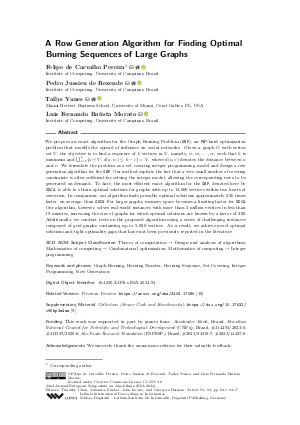@InProceedings{pereira_et_al:LIPIcs.ESA.2024.94,
author = {Pereira, Felipe de Carvalho and de Rezende, Pedro Jussieu and Yunes, Tallys and Morato, Luiz Fernando Batista},
title = {{A Row Generation Algorithm for Finding Optimal Burning Sequences of Large Graphs}},
booktitle = {32nd Annual European Symposium on Algorithms (ESA 2024)},
pages = {94:1--94:17},
series = {Leibniz International Proceedings in Informatics (LIPIcs)},
ISBN = {978-3-95977-338-6},
ISSN = {1868-8969},
year = {2024},
volume = {308},
editor = {Chan, Timothy and Fischer, Johannes and Iacono, John and Herman, Grzegorz},
publisher = {Schloss Dagstuhl -- Leibniz-Zentrum f{\"u}r Informatik},
address = {Dagstuhl, Germany},
URL = {https://drops.dagstuhl.de/entities/document/10.4230/LIPIcs.ESA.2024.94},
URN = {urn:nbn:de:0030-drops-211651},
doi = {10.4230/LIPIcs.ESA.2024.94},
annote = {Keywords: Graph Burning, Burning Number, Burning Sequence, Set Covering, Integer Programming, Row Generation}
}

 Creative Commons Attribution 4.0 International license
Creative Commons Attribution 4.0 International license
